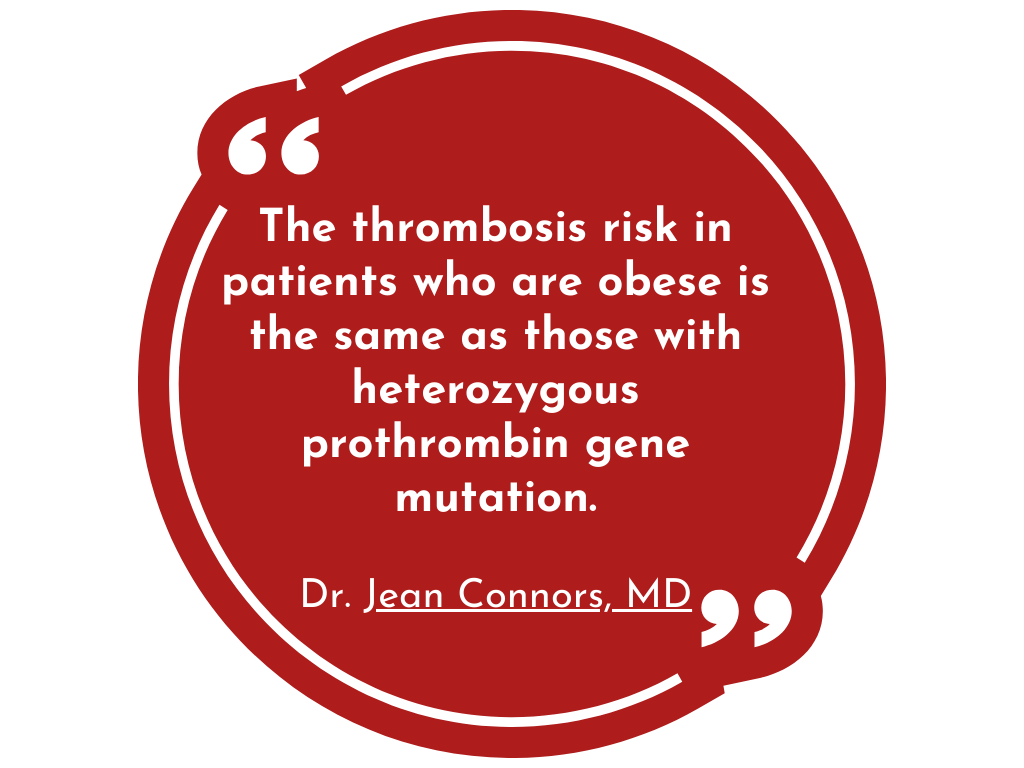My Mom had a saying, “it’s always in the approach.”
Wisdom tailor made for the awkward conversations about obesity.
How we approach someone with information dictates how they hear it and more importantly, move forward with it.
I know because I’ve lived the obesity conversations, more times than I care to admit.
The ones rooted in “tough love” were the worst.
So we’re going to talk about it together with the intent of making these conversations less awkward for you and your health care provider.
Because it’s not about a number on the scale, it’s about reducing a major risk factor for blood clots.
How We Talk About Obesity Matters
Let’s start with BMI – (body mass index) the tool most doctors use to size us up – no pun intended.
BMI by itself isn’t a perfect measurement for health. It doesn’t account for individual body composition – muscle mass, bone AND fat or where the fat is stored.
If BMI is used, it’s more helpful to ask your care provider to pair it with a tape measure for measuring waist circumference.
Research suggests that waist size is a better measurement than just BMI. (PMID: 2193761)
Weight alone isn’t the issue – we should be educating women on the types of fat that seem to matter most (visceral), where that fat is stored, and how it impacts other risk factors and total cardiovascular health.
Val Conley, Founder Speaking of Blood Clots
Obesity and Blood Clots – What’s the Link?
I can’t speak for every person that’s struggled with obesity. But I knew carrying excess fat was bad for my health.
I just thought I had time to put knowledge into action.
I didn’t know obesity is a major lifestyle risk factor for blood clots.
Visceral fat is more strongly associated with health risks like deep vein thrombosis (DVT), pulmonary embolism (PE), ischemic stroke, which occurs when a blood clot blocks an artery in the brain. and related conditions: high blood pressure, type 2 diabetes, high cholesterol and some cancers.
PMID: 33882682
Worse, obesity compounds other clot triggers like surgery, hormonal contraception, and menopause treatments.
Obesity is “synergistic” meaning the combined effects of obesity and other risk factors are greater together than the effect of individual risk factors on their own.
Women who present both obesity and use of combined oral contraceptives (COCs) have a greater risk (between 12 and 24 times) of developing venous thromboembolism than non‐obese non‐COC users. Obese women taking contraceptives should be viewed as an ‘at risk’ population. As such, they should receive advice to change their lifestyle, avoiding other cardiovascular risk factors, as a form of primary prevention. This indication should be extended to young women, as data show that COCs should be avoided in obese women of any age.
PMID: 36103980
Obesity and inflammation
We need Inflammation – it’s a natural response of the body to injury or infection.
Obesity produces low-grade chronic inflammation
Chronic inflammation raises the risk of blood clots and other cardiovascular health issues related to clots, like high blood pressure, diabetes, high cholesterol(Inflammation, Obesity, and Thrombosis)
Obesity tends to involve two types of fat:
Subcutaneous fat – under the skin and visible
Visceral fat – surrounds organs in the abdomen and is not as visible.
It’s visceral fat that releases a variety of inflammatory molecules into the bloodstream.
These molecules can disrupt the process of how the body clots, (coagulation cascade) leading to the formation of blood clots.
Visceral fat is considered pro-thrombotic, meaning it promotes the formation of blood clots.
Abdominal obesity appears to be a superior measure over overall obesity for detecting cardiovascular risk.
Waist circumference (WC) was the preferable indicator linking obesity to venous thromboembolism (VTE).
The estimated population attributable risk due to elevated WC was 23.7%.
A large proportion of VTE cases can be prevented if the population maintained a healthy BMI and WC.
Journal of Thrombosis and Haemostasis
Obesity can damage blood vessels by signaling the immune system to activate cells that may attack the tissues of the blood vessel walls.
This damage to the inner lining of the vessels, changes the way they function (endothelial dysfunction) and leads to the formation of plaques, which are fatty deposits that can narrow the blood vessels and reduce blood flow.
Over time, these plaques can become hardened and calcified, leading to a condition called atherosclerosis.
Atherosclerosis can cause further damage to blood vessels and increase the risk of blood clots, which can block blood flow to the heart or brain and cause a heart attack or stroke.
Obesity can impact physical activity, limiting blood flow, which results in blood pooling in the legs.
This pooling can lead to the development of deep vein thrombosis (DVT), a type of blood clot that can be particularly dangerous if it breaks loose and travels to the lungs.(PE or Pulmonary Embolism)
Obesity can also impact sleep, and may contribute to physical and psychological stress.
Obesity is a major modifiable risk that needs to be included in blood clot conversations for risk prevention and recovery, with empathy and a plan to improve visceral fat levels, especially for women considering hormonal contraception or menopause therapy.
